Academy of Music
The Academy of Music was built in 1871 at the corner of Washington and Hennepin Avenues in Minneapolis. It was built by Joseph Hodges.
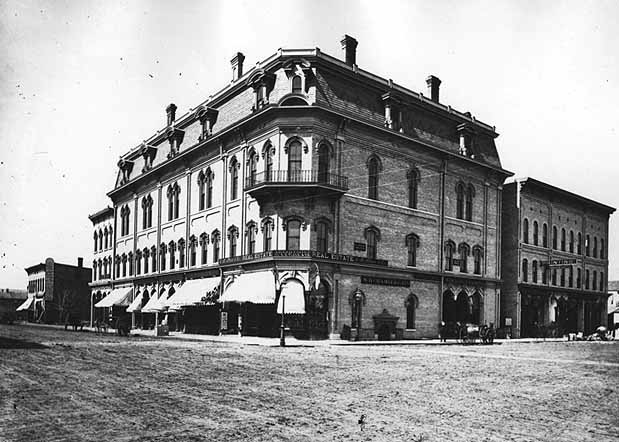
Photo @1874 by William Henry Illingworth courtesy Minnesota Historical Society
The building originally had three stories, and measured 80 feet on the Washington Ave. side and 114 feet on the Hennepin Ave. side. No where did I find an address or an indication as to what corner of the intersection the building was located, although my best guess is the southeast corner. It had a Mansard roof, with terra cotta window caps and galvanized iron cornices. The name of the building was on the Hennepin Ave. side.
The basement held the Central Hall, for use by organizations for parties, balls, banquets, and private functions. The Hall opened in mid-December 1871. It was equipped with a ladies reception room, stove room for cooking refreshments, coat rooms, and restrooms. It measured 110 feet by 40 feet, enough to accommodate 12 sets for dancing. (Minneapolis Daily Tribune, December 6, 1871). The YMCA held its Annual Festival and Oyster Dinner there on December 29, 1871.
The first floor hosted six shops, which had 15 ft. ceilings.
The main stairway to the second floor was on Hennepin Ave.; another was in the alley. The second floor had ten ft. ceilings. The second floor is divided into offices and the ticket office for the Academy of Music.
The Academy of Music was on the third floor of the building. The Minneapolis Daily Tribune described it at length on December 31, 1871:
To be appreciated it must be seen. It is 80 x 85 feet in front of the stage, and is divided into parquette, dress circle and balcony, and will seat about 1,600 persons. The parquette rises 18 inches, and each tier of the dress circle rises four inches, and in the balcony each circle rises nine inches. The parquette and dress circle are provided with upholstered orchestra chairs, and the balcony with reversible seats. The balcony is supported by iron columns, and has an iron rail upholstered in red plush. There are also proscenium boxes, each of which are ornamented with carved work. The extreme height of the building is 39 1/2 feet, and is supported by bolstering trusses framed and secured by rods in such a manner as to be void of any side thrust, leaving only a perpendicular weight upon the walls.
The walls are adorned with a portrait of Beethoven, which occupies a place in the center of the arch, while upon either side are stauettes of Misses Nillson and Kellogg. The dome, ceiling and walls have been frescoed by P. Clansen, and their appearance are really beautiful, and reflect credit on that skillful artist. There are two chandeliers suspended from the ceiling, each having fifty-six lights. The room is therefore brilliantly lighted to the remotest corner.
The stage is 33 feet deep and 78 feet wide with a proscenium arch 35 feet high and 30 wide. The drop curtain is really beautiful. It presents a mountain view as seen from the terrace of a castle. There are also eleven full sets of scenery, with sky and drapery borders, set-woods, water, &c. These are all the work of R.H. Halley, of London, an pupil of the great Telbin, and the equipments are equal to any theatre in the country.
The carpentering was done by David Pratt, who has been conneccted with McVicker’s theatre in Chicago for years, and has fitted this stage with all the appliances necessary to the production of any play. Above and on either side of the stage are six dressing rooms, all conveniently arranged.
Interestingly, the article makes much of the efforts to make the building fireproof.
The Academy of Music was dedicated on January 2, 1872.
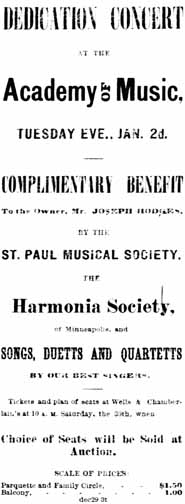
December 29, 1871, Minneapolis Daily Tribune
Early musicians and conductors were A.M. Shuey and pianist Ludwig Harmsen. The latter came to Minneapolis in 1868 and continued active in musical circles until his death in 1915. (Minneapolis Tribune, August 28, 1949)
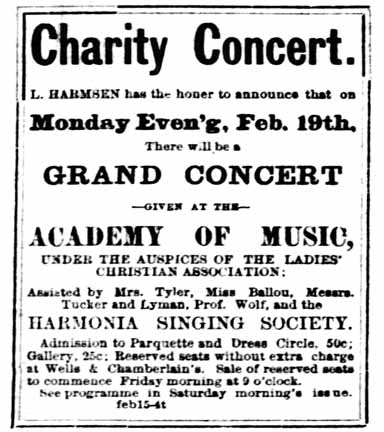
February 18, 1872 – Minneapolis Daily Tribune
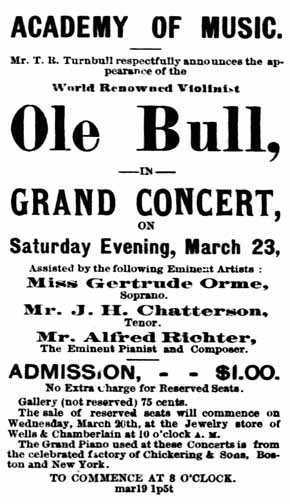
March 19, 1872 – Minneapolis Tribune
On May 1, 1873, Thomas Lowry and the Herrick Brothers purchased the building. Lowry sold his interest in 1875 to Dorillus Morrison.
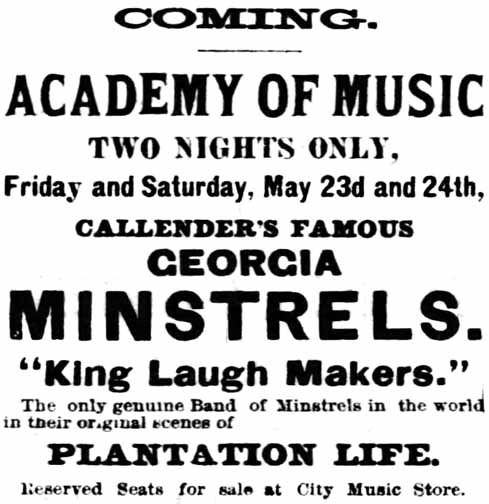
May 17, 1873, Minneapolis Daily Tribune
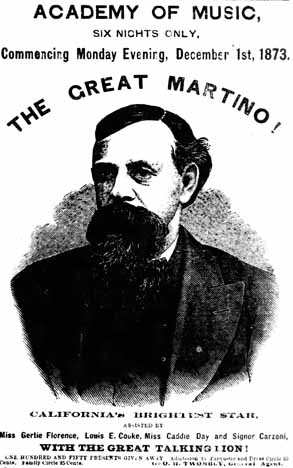
December 2, 1873 – Minneapolis Daily Tribune
The Herrick Brothers redecorated and added new scenery and dressing rooms in 1876. At that time the building was deemed to be unsafe if a fire were to break out, so a third egress stairway was added.
An article in the Daily Minnesota Tribune (January 1, 1883) indicated that the Academy had “outgrown its usefulness” and that a portion of the Syndicate Block was being made into an Opera House to replace it, to be ready in the middle of February 1883.
On March 24, 1883, the Daily Minnesota Tribune reported that the Academy of Music would soon be reconstructed into a handsome business block, six stories high.
It is clear that the new Opera House replaced the Academy of Music, as the sale of tickets to the Grand Opening of the Grand Opera House was conducted at the Academy in March 1883.
The last performance at the Academy was the comic opera “The Electric Spark” by Atkinson’s Jollities on March 28 and 29, 1883.
On March 30, 1883, the Daily Minnesota Tribune gave this eulogy:
The curtain was rung down for the last time at the Academy of Music last evening, and this well known place of amusement will soon be transformed into a business block in which green rooms, supes, and transformation scenes will be known no more. The building has served its day and generation well; and though the onward course of events has pushed it aside and it is no longer equal to the demands made upon it, but must give place to a newer, better and more pretentious rival, it will always be remembered by those who have been amused or instructed within its walls with gratitude and pleasure. The company that had the honor of closing its career as a place of amusement was Atkinson’s Jollities. Soon bricklayers and carpenters will so transform it that it will be speedily forgotten by the throngs of amusement seekers, but nevertheless many will remember the good times spent in the Academy of Music long after all trace of it has been obliterated by the onward march of the city.
An ad by Big Boston, a clothing store in the building, announced a sale necessitated by the pending demolition of the building by July 1, 1883, and the erection of an 8-story block (large building) in its stead. (Daily Minnesota Tribune, May 1, 1883). It didn’t happen, and Big Boston was still in the building to the end.
Instead of being totally demolished, the building was gutted, enlarged from three stories to five, and turned into an office building in 1883. Only the outer walls of the original building were used. The reconstructed building was ready for occupancy on November 1, 1883. Indications are that the building continued to be known as the Academy of Music Block
THE GREAT ACADEMY OF MUSIC BLOCK FIRE
The building burned to the ground on December 25, 1884. Several factors made this fire almost impossible to put out: (Minneapolis Tribune, December 26, 1884)
- The call was put in at about 3:30 pm; as it was a holiday, the building was virtually vacant, but at the same time, it was difficult to find firemen.
- The temperature – 15 below during the day, 30 below by midnight – put the firemen in danger, turned the water to hail, burst a hose, and turned the street into a skating rink.
- From newspaper reports, it doesn’t sound like the source of the fire was ever found. A Tribune reporter was on the scene almost immediately, and entered the building to investigate, but smoke pushed him out quickly. A fireman made it to the fifth floor, where he got trapped and for some tense moments until a ladder finally made it to him and he was rescued.
- The building was deemed “a fire trap” more than once in the article and no one wanted to risk life and limb to go in.
- Individual gas meters were exploding, adding to the danger.
- The building had a glass skylight and a saloon with a large plate glass window; all of the windows eventually burst from the heat of the fire or the effects of the water/ice.
The Minneapolis Tribune reported that “The crowd seemed to be having an extraordinarily good time.” In other words, there was some looting going on, especially at E.H. Steele’s Boston One-Price Clothing Store. One man was caught wearing three coats and was thrown in the clink.
The report hints that the fire started in a back elevator shaft, but it is not an official report from the fire department.
THE LAW LIBRARY
The Minneapolis Bar Association’s law book collection was lost as well.
Nearly two years ago Thomas Lowry kindly donated his splendid collection of almost 1,800 volumes to the lawyers of Minneapolis, and they immediately formed a library association. The collection has been continually added to until there were upward to 5,500 volumes in the library. The value of the collection is placed at $18,000. ($15,000 was insured.)
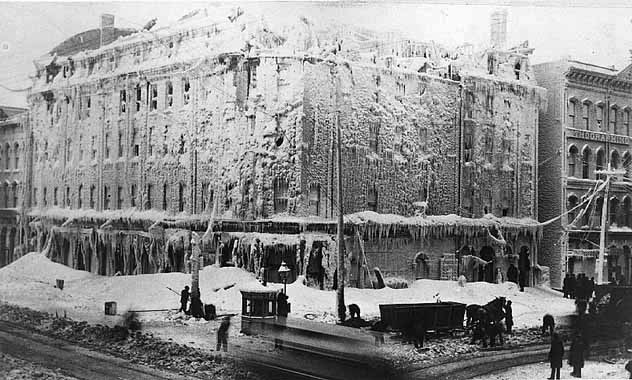
December 25, 1884 – photo courtesy Minnesota Historical Society
Demolition of the building began in March 1885. The Temple Court business block was constructed in its place. A look at the current map shows three of the four quadrants of the intersections as vacant land, and the fourth as a building built in 1964.
